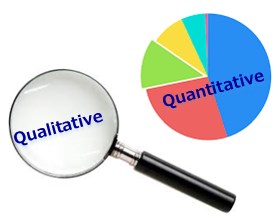Quantitative and Qualitative Evaluation Methods
Evaluation methods can be either quantitative or qualitative. Most training evaluation processes include a combination of both of these methods. This is because the combination generally provides the best overall assessment of the program.
Quantitative Methods – generates numerical data or data that can be transformed into usable statistics in order to analyze and interpret information.
Qualitative Methods – used to gain an understanding of underlying reasons, opinions, and motivations.
About Quantitative Methods
Quantitative methods involve the use of numerical data to analyze and interpret information. The information obtained produces data that can be counted, categorized, measured, or ranked. This information can be evaluated using statistical analysis which offers the opportunity to dig deeper into the data and look for the meaning behind it.
Typically, rating scales or closed questions are used to generate quantitative data as these produce either numerical data or data that can be put into categories (e.g. “yes’ or “no” questions).
After collection, this data can then be evaluated using statistical analysis and easily placed into graphs and tables. The results from quantitative methods are easy to summarize, compare, and generalize.
Quantitative methods can answer such questions as;
- How many people attended?
- How much did the training program cost?
- How many workshops did you complete?
- How many people completed or passed the program?
- What were the assessments outcomes?
Quantitative Data Collection Methods
- Interviews
- Questionnaires
About Qualitative Methods
Qualitative methods involve gathering information that is not in numerical form. It is descriptive data of events, people, situations, and observed behaviors. It is typically opinions, beliefs, and attitudes of individuals who attended a training program or those impacted by a program.
The questions and methods used to gather qualitative data tend to be open?ended and less structured, thus harder to measure than quantitative data. However, the data is helpful as it can provide contextual information to clarify potential issues by explaining the “why” and “how” behind the issues.
Qualitative data methods can answer such questions as;
- What did participants get out of the program?
- Why did participants feel the program was beneficial?
- How will participants be able to use the information provided?
- What are some challenges participants found with the program?
Qualitative Data Collection Methods
- In?depth interviews
- Observation methods
- Document review
- Focus groups

